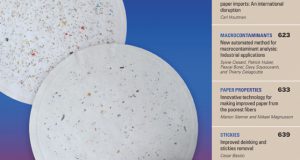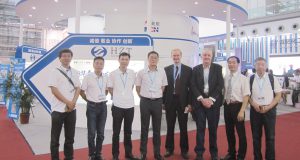ANDREW JACKSON
In concluding a 2009 survey of optical brightening agents (OBAs)1, I wrote that, despite the difficulties faced by both producers and customers during an economic downturn, there was every reason to believe that OBAs would have a bright future. In some ways, little has changed in the intervening years, despite the highly competitive market in which we find ourselves today.
THE SITUATION TODAY
 A steady decline in production volumes of office papers has had a knock-on effect on demand for OBA, despite a continuing interest worldwide in producing papers with higher levels of whiteness and contrast. With OBA production capacity well exceeding demand, purchasers focused on unit price have been able to take advantage of some remarkably low offers in the marketplace as suppliers fight tooth-and-nail for volume.
A steady decline in production volumes of office papers has had a knock-on effect on demand for OBA, despite a continuing interest worldwide in producing papers with higher levels of whiteness and contrast. With OBA production capacity well exceeding demand, purchasers focused on unit price have been able to take advantage of some remarkably low offers in the marketplace as suppliers fight tooth-and-nail for volume.
It is hardly surprising that we have heard of some suppliers resorting to desperate measures to save on costs: In a stand-out example, it is reported in the marketplace that several mills in the United States have seemingly been supplied disulphonated OBA diluted with less-expensive and lower-performing tetrasulphonated OBA (Fig.1).
At the same time, some legitimate reductions in OBA pricing have been made possible through lower raw material costs in certain areas. Since 2009, the dollar price of diaminostilbene disulphonic acid (DAS)—the raw material with the greatest cost contribution to di- and tetrasulphonated OBAs—has fallen by more than 20 percent. On the other hand, the production cost of hexasulphonated OBAs has been adversely impacted by a price increase of 65 percent for the key ingredient: aniline-2,5-disulphonic acid. Nonetheless, reports in the marketplace are that OBA imports into certain countries are continuously priced below domestic market prices, resulting in market share gains for importers. It is a challenging marketplace.
SUSTAINABILITY AND HIGH-YIELD PULPS
If one needs any evidence of the critical importance of sustainability to the paper industry, it can be found in the high prominence given to the topic on the website home page of virtually any major paper producer. Yet sustainability has both economic and environmental components; suppliers must remain competitive while investing in improvements to quality that reduce environmental impact. Though OBAs may not seem the most obvious source of sustainability gains, a closer look shows that significant reductions in the environmental footprint can be made by their correct application.
For example, consider the trend toward increasing use of high-yield pulps (HYP), with their obvious sustainability advantages over low-yield, bleached chemical pulps. Key to the successful implementation of HYP is the ability to reach the higher brightness levels of chemical pulps. While peroxide bleaching has been the traditional route to higher brightness levels of HYP, recent studies have promoted OBAs as a more sustainable solution.
A study published in 1999 highlighted the lower environmental impact of OBA relative to peroxide coming from reductions in some of the mill effluents and in the overall material intensity of the brightening process2. While the 2009 study left open the question of any possible impact of OBA escaping into the environment, this was taken up in a 2010 Swedish National Screening Programme3. The concentration of tetrasulpho OBA, the type most commonly used in Nordic mills, in the influent to three waste water treatment (WWT) plants was measured to be about 10 µg/l, already 20 times lower than the predicted no-effect concentration (PNEC). The efficiency of the WWT plants at removing tetrasulpho OBA was found to exceed 90 percent, resulting in a highest measured concentration in surface water of more than 600 times lower than the PNEC.
He and co-researchers4 studied the partial replacement of peroxide by OBA in the HYP bleaching process and concluded that not only was OBA chemically resistant to the process conditions, but also that there were advantages to adding OBA at the pulp mill; these included (1) improved OBA efficiency; (2) less interference from cationic polymers; (3) less interference from metal ions; and (4) decreased color reversion. A more recent paper from the same research group5 highlighted the gains from a combined peroxide/OBA bleaching process over the conventional peroxide process: (1) higher pulp yield; (2) lower COD and anionic trash formation; and (3) lower bleaching chemical cost. Liu and others6, while emphasizing the environmental credentials of HYP, have concluded that by using OBAs and colorants to compensate for the lower brightness and whiteness, coated papers containing up to 40 percent HYP are possible without any significant negative effect on paper quality.
CONCENTRATED LIQUID OBA
What of the optical brighteners themselves, which traditionally have been marketed as aqueous solutions of about 20 percent actives content? While the solution form is clearly preferred by papermakers because of its ease of metering and safe handling, is there a sustainability case for supplying OBAs in powder form? Certainly the more concentrated powder form would allow fewer deliveries and consequently lower greenhouse gas emissions from sea, road, and rail transport.
In reality, the argument is false. OBAs are produced as aqueous solutions, and the removal of water to generate a powder form is an energy-intensive process—and an added cost. An internal calculation indicates that to remove the  water from 100 tons of standard liquid tetrasulphonated OBA would not only increase cost of production, but also create a carbon dioxide impact of more than 25 tons.
water from 100 tons of standard liquid tetrasulphonated OBA would not only increase cost of production, but also create a carbon dioxide impact of more than 25 tons.
OBA producers led by Archroma are moving the paper industry toward a more sustainable solution by promoting concentrated liquids7. By increasing the actives content up to about 30 percent, reductions of global-warming emissions through transport of up to 33 percent become possible.
SURFACE TINTING
The use of tinting dyes and pigments at the wet end of the paper machine is a well-established method for controlling both whiteness and shade. Yet their application, and their ability to substitute for OBA, is restricted because of their absorption of visible light in the region of 457 nm, which inevitably diminishes the brightness of the paper.
A new development from Archroma, marketed under the name Advanced Whitening, aims to reduce the OBA dosage required to reach whiteness targets by up to 20 percent8. Such large savings in OBA demand have been made possible by the identification of a surface tinting dye that builds whiteness with only marginal loss of brightness. The papermaker not only takes part in a sustainability gain, but reduced production cost while producing a paper with a truly clean, white appearance that affords excellent print contrast.
COLORLOK®
Walk into any office supplies store and you will find an increasingly large selection of reams of printing paper carrying the ColorLok logo. (ColorLok is a trademarked brand and licensing program marketed by HP and International Paper; worldwide, more than 100 brands have been certified to use the logo.) In 2016, sales of ColorLok paper were reported to have exceeded four billion reams9. ColorLok technology has been disclosed as a divalent salt that immobilizes ink pigments at the paper surface10. While the technology delivers improved optical density, color saturation, and edge sharpness, it is recognized as having poor compatibility with optical brighteners. Western OBA  producers have accordingly invested heavily in research to develop brighteners with an improved performance in ColorLok grades.
producers have accordingly invested heavily in research to develop brighteners with an improved performance in ColorLok grades.
Figure 2 illustrates the substantial improvement in performance gained from a patented sizing formulation using a specific hexasulphonated brightener. Even at OBA dosage levels into the sizing composition of 40 g/l and above, the impact of the divalent salt on whiteness is minimal. The choice of divalent salt can also have a significant effect on the ability of the OBA to build whiteness, with magnesium salts having been shown to have a better OBA-compatibility than calcium salts11.
OUTLOOK
A continued interest in the use of optical brighteners as an environmentally-responsible and cost-effective way to produce high-contrast white papers seems assured. Customers looking to take advantage of technological developments will rely on the support from established producers who can offer innovation and service across a complete whiteness package.
On the other hand, the appearance of new OBA producers into a market that was already over capacity and low on profitability has led to an unstable situation in which either consolidation or the exit of certain producers is an inevitable outcome. Customers would do well to make their own quality control of incoming material.
References:
1 Jackson, A. Pulp & Paper International, May 2009, 32-34.
2 Scheringer, M., Halder, D., Hungerbühler, K. Journal of Industrial Ecology, 1999, 3 (4), 77-95.
3 Results from the Swedish National Screening Programme 2010. Subreport 2. Fluorescent Whitening Agents. IVL report B1995. Available (June 2016) at:
www.ivl.se/download/18.343dc99d14e8bb0f58b7602/1454339559469/B1995.pdf
4 He, Z., Zhang, H., Ni, Y., Zhou, Y. Pulp & Paper Canada, March 2009, 18-23.
5 He, Z., Zhang, H., Chen, Z., Li, Z., Ni, Y. Journal of Pulp and Paper Science, 2010, 36 (12), 49-53.
6 Liu, H., Chen, Y., Zhang, H., Yuan, Z., Zou, X., Zhou, Y., Ni, Y. Industrial & Engineering Chemistry Research, 2012, 51, 4240-4246.
7 Archroma News Release 27 June 2016 Archroma Launches a New Concentrated OBA with Reduced CO2 Footprint, available (June 2016) at: http://archroma.com/newsroom/news-releases/
8 Archroma News Release, 21 April 2016
New Archroma Advanced Whitening Concept Provides Papermakers with Truer Whites and Customizable Formulations, available (June 2016) at:
http://archroma.com/newsroom/news-releases
9 Opi Magazine, April 2016, page 49, available (June 2016) at:
https://issuu.com/opimagazine/docs/opi_us_258_april_16
10 See (June 2016)
http://www.colorlok.com/colorlok-technology.html
11
See for example European Patent 2,260,146 B1
Andrew Jackson is global product manager – optical brightening agents, paper solutions at Archroma.
 Paper 360
Paper 360


